SECURITY, GUNS AND POLICE IN JAPAN
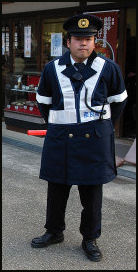
Japanese policeman Most police duties in Japan are handled by the National Police Agency (NPA). Established in 1945 after World War II, it is run by 500 administrators who give out orders and have no experience in the field. About 230,000 provincial police work the beats like soldiers in an army and follow the orders of their superiors. There are also municipal forces like the Metropolitan Police Department in Tokyo.
Special Assault Teams (SAT) are the Japanese equivalent of SWAT teams. Regarded as the best and the brightest in the police force, they are trained to handle terrorist incidents and hijacking. Their very existence was secret until a few years ago. Currently there are 300 people in SAT units in eight prefectures. Other special units include the Special Investigation Team and the Osaka-based Martial Arts Attack team.
Japan has no national investigative force like the F.B.I. (a consequence of the anti-militaristic constitution) and as result things like national banking scandals, aircraft accidents and drug trafficking are handled by local officials. The Public Security Investigation is closest thing to the FBI.
In an effort to nab fugitives, pictures of Japan's most wanted criminal are pictures with a toll-free number on cigarette lighters, packages of tissues and posters in subway stations, post offices and police stations.
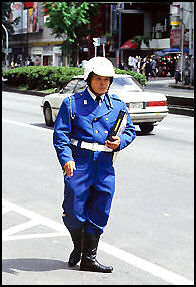
Good Websites and Sources: Good Photos at Japan-Photo Archive japan-photo.de ; Wikipedia article on Law Enforcement in Japan Wikipedia ; National Police Agency npa.go.jp/english ; Police of Japan (a detailed look) pdf file npa.go.jp/english/kokusai ; Koban Pictures www.koban.fr ; New York Times article on Confessions by the Innocent (2007) nytimes.com ; Police and the Justice System Reform in Japan ikjeld.com/japannews/JusticeSystemReform ; Police Corruption tokyoprogressive.org ;
Gun Control in Japan guncite.com/journals ; A Conservative American Look at Japan’s Gun Control Laws davekopel.com
Tokyo Metropolitan Police Department offers special tours five times a day (9:00am, 10:30am, 12:30pm, 2:00pm and 3:30pm). The tour includes stops at the Police Museum, Communications Control Center and the Traffic Control Center. Reservations need to be made in advance. This can be done by contacting the Public Relations Department of the Tokyo Metropolitan Police by fax (☎ 81-3-3581-3924).
Links in this Website: CRIME IN JAPAN Factsanddetails.com/Japan ; THEFTS AND ROBBERIES IN JAPAN Factsanddetails.com/Japan ; JUVENILE CRIME IN JAPAN Factsanddetails.com/Japan ; FAMOUS MURDERS IN JAPAN Factsanddetails.com/Japan ; FAMOUS MURDERS IN JAPAN INVOLVING CHILDREN Factsanddetails.com/Japan ; YAKUZA AND ORGANIZED CRIME IN JAPAN Factsanddetails.com/Japan ; YAKUZA ACTIVITIES AND VIOLENCE Factsanddetails.com/Japan ; AUM SHINROKYO CULT AND THE TOKYO SUBWAY SARIN GAS ATTACK Factsanddetails.com/Japan ; SECURITY, GUNS AND POLICE IN JAPAN Factsanddetails.com/Japan ; LEGAL SYSTEM IN JAPAN Factsanddetails.com/Japan ; DEATH PENALTY AND PRISON IN JAPAN Factsanddetails.com/Japan
Japanese Policemen
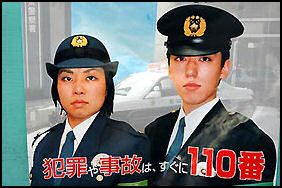
police poster Japanese policemen are often scrawny, unthreatening guys that either walk their beats or putter around on motorscooters. Known affectionately as “mawari-san” ("Mr. Walkabout"), they spend most of their time in their koban (See Below) and sometimes live with their families in small stations called “Chuzai-sho”. For a long time police were required to visit every home in their jurisdiction twice a year, an act viewed favorably by most Japanese and were widely involved in community activities. Some police have connections with right wing groups.
Most police carry a baton and a few carry guns. Police in Tokyo are issued a collapsible aluminum baton that is 53 centimeters long when extended. Those that carry guns are issued a .38-cal. New Nambu revolver.
After a number of attacks on police in the early 2000s, including the stabbing of a police officer by a third grader, police were issued knife-resistant gloves and bigger heavier batons, The new batons, made of thick aluminum, are light bit strong enough to break through a car window and designed to counteract attackers with knives. They old batons were made of wood.
So few police carry guns that police working a major summit meeting in 1995 had to be taken to a shooting range and given a crash course in marksmanship. During his 15-years as a Tokyo police officer, Tadashi Kohara told AP that he had only drawn a gun once and that was with an altercation with drunk who punched him.
Some police patrol unarmed on bicycles. Sometimes the bike are nothing more than battered old bike with a basket at the front. When asked if he would chase a bicycle thief with fancy new bike on his battered old bike one policeman told the Los Angeles Times, “Oh I can’t compete...But we would have done our best.”
In October 2009, the Tokyo police “cold case” squad was created to investigate 56 unsolved murders and other serious unsolved crimes, to take advantage of DNA testing and other new investigative technologies.
Koban
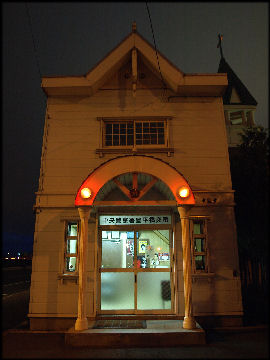
Koban Koban are tiny box-like neighborhood police stations. The are the foundation of the Japanese police system, giving police a visible presence in an area and providing a place that residents can go to get help or assistance if they need it. Police are oriented towards the koban system rather than patrolling in cars. They patrol on foot and by car, using the koban as their base but also spend a lot of time just hanging out in the koban.
There are around 6,600 koban in Japan. They are usually staffed by two or three officers and are usually small two-story buildings positioned at intersections near train station or some other easily accessible spot. They are expected to be open 24 hours a day, 365 days a week. Sometimes no one will answer when you knock on the door. Sometimes that is because the policeman on duty is taking a nap.
Koban are set up to monitor activities in their communities and, theoretically at least, respond quickly to crimes and accidents. Japanese have traditionally gone to their local koban when there was a problem and the policeman there helped them. Of times the primary tasks performed by koban police are giving out directions and filing reports for lost dogs and stolen bicycles. These days the koban boxes are often empty as the police are on patrol or investigating something. Sometimes retired police officers man the koban when the regular police officer are not there.
The koban concept has been tried din Britain, Cambodia and other places with some success.
Japanese Police and the Community
Police in Japan are regarded more as community assistants than crime fighters. You are more likely to see a policeman comforting a lost child until his mother can be found than catching criminals.
Police sometimes provide money to people who lost their wallets and can't afford a subway ticket. Anyone in Japan go up to a policeman and claim they have no money and borrow $10 or $20 with no questions asked. The assumption is that you have be desperate to ask a policeman for money and you will pay the money back when you can.
Japanese police have traditionally kept on top of what is happening in their beats, responding to tips and gossip, and often prevented crimes before they occur. Gangsters, motorcycle gang member, right extremists and other troublemakers are often all accounted for by the government. In trouble areas, police often know where to find these people.
Many Japanese police cars have sirens that can be extended upwards from the roof with an accordion-like devise so the siren is more visible in thick traffic. Many have video cameras with infrared, night-vision capabilities and zoom lenses. The cameras were added after an number of incidents in which suspects escaped from police by ramming their vehicles into the police cars.
Japanese police officers are increasingly being swamped by non-urgent calls from people seeking help for things like fixing a washing machine, getting money from a parking machines and tracking down girls met online. Many calls are about excessive noise or noisy teenagers in their neighborhood. In 2010 over 1 million such calls were made to the police emergency 110 telephone number.
Using Security Cameras to Nab a Tokyo Murderer
In December 2012, The Yomiuri Shimbun reported: ‘security cameras set up at various places in Tokyo helped police identify a suspect in a recent murder case, even though the man changed his clothing repeatedly to disguise his appearance. The suspect, Genki Matsuo, 22, was arrested on suspicion that he withdrew cash from the bank account of Kumi Arai, a 34-year-old homemaker in Itabashi Ward, Tokyo, who had been stabbed to death on November 21. The security cameras recorded images of the man wearing different types of clothing, from suits to a knit cap, mask and sweater. [Source: Yomiuri Shimbun, December 3, 2012]
Investigators of the Metropolitan Police Department identified the suspect despite the disguises by collecting images from the security cameras at train stations, convenience stores and other places. Soon after the murder, the MPD compared images recorded by a camera built in the intercom system in the apartment building where Arai lived with photographs of crime suspects that the police kept on file. The investigators found the image of the man was similar in appearance to Matsuo, who was investigated in January by Itabashi Police Station in the theft of lost or mislaid property.
On November 22, the day after the murder, the police learned that money had been withdrawn from Arai's account at an automated teller machine at a convenience store near Ikebukuro Station. The man who withdrew the cash wore a knit cap, mask and scarf, apparently to conceal his face. The police pay particular attention to the cast of a person's eyes when searching for a suspect in a crowd. The characteristics of the eyes of a man withdrawing cash at the ATM and those of the man in the intercom camera images appeared similar. In addition, similar glasses with black frames were worn by both men. This deepened the suspicion of MPD investigators that Matsuo was the man they sought.
The investigation headquarters set up at Takashimadaira Police Station collected photo images from security cameras near the convenience store and analyzed them. More than 20 officers, about half of the investigators in the case, were given the task of analyzing data from security cameras. The investigators looked through a huge number of photos searching for a person matching the suspect's appearance by checking faces, clothing, height, physical features and gait.
They learned that a man had bought a knit cap, sweater and scarf--similar to those used by the suspect at the ATM--at a clothing store near the convenience store, about 30 minutes before the victim's money was withdrawn. In addition, the investigators learned from the photos that a man in a suit had changed his clothing in a pachinko parlor's toilet. The deciding factor was security camera images of a man who removed his mask near the convenience store to clearly show his face. As a result of graphic image analysis, the police identified the man as Matsuo and it was used as grounds for requesting an arrest warrant. "In urban areas, it's difficult to obtain good information by interviewing residents, so security cameras are a very useful tool," a senior MPD official said. "They will continue to be used to provide objective evidence.”
Money Rewards for Crime-Solving Tips in Japan
In August 2012, The Yomiuri Shimbun reported: “The National Police Agency has announced that the 20 million yen reward for information that led to the arrests of former Aum Supreme Truth cult members Naoko Kikuchi, 40, and Katsuya Takahashi, 54, will be paid to three people. This is the second time a reward will be paid since the reward system using public funds was introduced in May 2007, following the 2007 murder of British woman Lindsay Hawker. The culprit in the case, Tatsuya Ichihashi, 33, was arrested and sentenced to life imprisonment thanks to information from the public. [Source: Yomiuri Shimbun, August 11, 2012]
For information on Kikuchi, who has been indicted for aiding attempted murder and other charges, 10 million yen will be paid to one person. As two people contributed to the arrest of Takahashi, who has been indicted for murder and other charges, 10 million yen will be split between them based on their contributions. To protect the informants' identities, the NPA did not release their personal information, including their gender, or the distribution ratio.
The reward for the fugitives was initially 5 million yen each--2 million yen from a private organization of retired police officers and 3 million yen in public funds. But after another former Aum member, 47-year-old Makoto Hirata, who has been indicted for illegal abduction and confinement, turned himself in, public attention on former Aum members increased and the NPA decided to raise the rewards to 10 million yen.
Japanese SWAT Team in Action
In November 2012 The Yomiuri Shimbun reported: “In a mere minute, Special Investigation Team members pounced on and arrested a hostage taker at a bank in Toyokawa after quietly sneaking into the building to end a nearly 13-hour standoff. Koji Nagakubo, 32, took five hostages at knifepoint at the Zoshi branch of Toyokawa Shinkin Bank in the city. With the situation in a deadlock, a turn of events finally took place at about 2:30 a.m. Friday when an investigator closely monitoring the situation inside the bank through an opening in the curtains confirmed that Nagakubo, who was sitting on a sofa, had dozed off. [Source: Yomiuri Shimbun, November 25, 2012]
Inside, a 19-year-old female bank employee was seen with her hands tied. She was also bound with a length of vinyl to Nagakubo's left hand. In his right hand, Nagakubo had kept a survival knife with an 11-centimeter blade pointed toward her, but the knife was now pointing away. After confirming this, the police prepared to storm the branch at about 2:40 a.m. Eight members of the SIT squad climbed a ladder to the second-floor balcony of the building. A blue flame appeared as one of them made a hole in the window, and unlocked it through the opening.
The member then quietly slid open the window and the squad snuck into the room one by one while the hostage taker remained oblivious to the operation. At this stage, 12-1/2 hours had passed since the crisis began. SIT members made their way downstairs and peered into the area where the hostages were being held. At 3:07 a.m., they confirmed Nagakubo was sleeping on the sofa, about six meters away from their location. Five other SIT members stood by outside one of the doors of the building.
After a count of five, all 13 members stormed the area. One of the members tore off the cord tying the female employee to Nagakubo with his bare hands, while others secured the knife. The culprit fiercely resisted arrest but in vain. The bust was over in about a minute. The SIT is a crime squad set up within the first investigation division of the Metropolitan Police Department and the Aichi prefectural police among other police forces.
The team, which consists of a storming unit, negotiators and reconnaissance, deals with rescue operations mainly for abduction and hostage cases, and also arrests culprits. After a 2007 hostage-taking case in Nagakute, Aichi Prefecture, in which a police officer was shot dead, the Aichi prefectural police strengthened the SIT, raising the number of storming unit members from five to 13.
Japanese Police Inaction
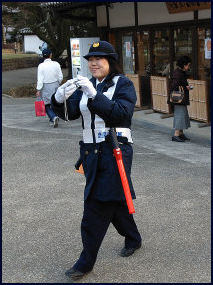
policewoman The police are sometimes criticized for inaction. You rarely see them investigating crimes or questioning potential criminals or even writing parking tickets for illegally parked vehicles or using radare guns to catch speeders.
The far-right harasses people and the yakuza goes about their business with little interference from the police. When asked why he didn't do anything about motorcycle gangs roaring through residential areas at break neck speeds on policeman told AP, "We could catch them if we wanted to. But they would get hurt and we would get hurt."
Japan's criminal investigation system is hopelessly incomplete and out of date. Investigators often act on hunches and instinct and don't write information on crimes reports or enter it in databases so it can shared with police all around the country.
A lot of police time is wasted or spent doing nothing. Emergency lines are often swamped with frivolous calls such as people asking police to drive them home because it is raining. In September 2008, 50 police officers were summoned to capture a naked foreigner swimming in the moat of the Imperial Palace.
Hiromasa Saikawa, a former policeman who quit the force in disgust over “fishy” police practices, told the Los Angeles Times, “You can commit a perfect murder in Japan because the body is not likely to be examined.” He said senior police officer are “obsessed with statistics because that’s how you get promoted” and try tp keep the number of reported crimes in their districts as low as possible. “All the police care about is how they look to people; it’s all PR to show that their capabilities are high.”
Criticism of the Japanese Police
In the late 1990s and early 2000s Japanese police were under fire for incompetence, corruption, inefficiency, not investigating complaints, loafing on the job and changing the information on reports. Police, for example, were warned in advance that Aum was going to launch a subway attack in 1995 but botched their effort to stop it and then took six weeks to round up and arrest the perpetrators.
The arrest rate for crime in 2001 was 19 percent, down from a record high of 70.4 percent in 1953. According to a newspaper poll in the spring of 2000, only 38 percent of respondents said they trusted police and 60 percent said they didn't trust them. Two years earlier 70 percent of the respondents said they trusted police.
The police are so wimpy they once went to the house of a white collar criminal, who locked the door when the police arrived. Instead of knocking down the door and immediately arresting the man the police waited outside for six hours while the criminal inside burned documents that could prove his guilt.
In April 2009 a prisoner being interrogated escaped after the police officer questioning him fell asleep because the prisoner slipped sleeping pills into his tea. The following month a man who murdered two people escaped while a police officers was radioing for help after the killer pretended to be a relative of the victims.
Police in Shimane have been ordered to carry emergency alarms — like those used by school children for protection from creepy strangers — to protect themselves. The order came after middle students stabbed an officer inside a substation in Miyagi Prefecture in an attempt to steal the policeman’s gun. One policeman was found guilty of cruel treatment for making a suspect step on papers bearing the names or relatives.
Japanese Police Scandals, Crimes and Suicides
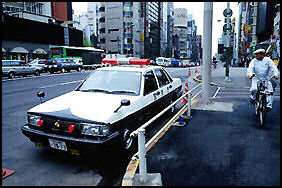
police car In 1999 there was a series of scandals involving police officers. In Kyoto, two officers were arrested for selling amphetamines. In Osaka, a sergeant was arrested for providing Japanese passports to illegal immigrants. In Kanagawa Prefecture, which includes Yokohama, senior police were accused of brutally hazing their subordinates with a loaded gun, handcuffs and electric shocks, using compromising photographs obtained from gangsters to blackmail a woman for sex, destroying evidence, and appropriated items that had been seized for themselves.
In March 1995, National Police Agency chief Takaji Kunimatsu was shot three times outside his apartment but survived. In 2010 the statue of limitation on the crime ran out. The gun man was never caught. The investigation of the case was poorly handled. The Aum Supreme Truth cult was believed to be behind the attack, which took place shortly after the Tokyo sarin gas attack, but not enough evidence was gathered to issue any arrests. The shooter was believed to be a former policeman who was a member of the cult. He reportedly confessed but was never arrested and a careful investigation was never done out of worries about publicity reflecting poorly on the police. In 2011, Tokyo police admitted the failure to solve the crime was the result of shoddy investigations and slow efforts to substantiate allegations.
In February 2000, while six police officers in Kyoto were questioning a 21-year-old man who fatally stabbed a 7-year-old boy at a primary school, the man escaped and ran away into a crowded market place and eventually made his way to an apartment building and jumped to his death from the 13th floor.
In April 2000, a 21-year-old woman was stabbed to death by a persistence stalker. It turned out the woman had repeatedly sought the help of police, who did nothing. They even encouraged the woman to drop her complaints because they were “very busy."
See Girl Who Disappeared for Nine Years, Famous Crimes
In the mid 2000s there were a number of cases of police officers killing themselves with the weapons. In 2006 alone nine officer killed themselves with their own weapons. In August 2007, a police office in Tokyo shot a woman to death with a police-issued weapon and then killed himself. It was revealed afterwards that the police office had a history of odd behavior.
Police have been arrested for bribery and fraud, in many cases because they were deeply in debt because of loans or gambling problems. One officers stole ¥5.5 million in three robberies to help off debts from house and car payments. Another took two gold bars worth ¥7.5 million kept in a police station and sold them to a pawn shop. He owned ¥14 million to a consumer loan firm and accumulated debts from horse racing. In May 2007, a police officer was arrested for his involvement n a bid-rigging scheme in which he mediated a meeting between a mayor and a construction firm in which a shady deal was made,
In December 2009, a 21-year-old Kobe Police officer and three others were charged with confining and beating a 19-year-old student, who suffered a broken nose and ribs and was given hardly anything to eat during his four days confinement for badmouthing the police officer’s girlfriend.
In October 2009, a policeman in Hyogo Prefecture was arrested for stealing the underwear of a 14-year-old girl while visiting her house to question here about a crime.
In September 2009, a Fukuoka police officer was disciplined for causing a hit and run accident while driving drunk in the wrong side of the road. A woman was injured in the accident. A blood test conducted 10 hours after the accident found alcohol levels four times above normal.
Female Police Officer Ordered to Undress at 'Farewell Party'
In July 2012, the Yomiuri Shimbun reported: “Four male officers of the Kanagawa prefectural police have admitted to sexually harassing a fellow female officer this March, forcing her to take off her clothes and giving her an unwanted kiss, The Yomiuri Shimbun has learned. The prefectural police announced that it will soon punish the four officers, but said it was "impossible to build a case" for a criminal investigation. [Source: Yomiuri Shimbun, July 28, 2012]
According to a senior officer of the prefectural police, the four officers--all in their 30s--worked at Yamato Police Station. One was a police sergeant in the criminal affairs No. 2 division and is now working at the organized crime control division for the prefectural police. The others are a sergeant in the traffic No. 2 division, an assistant police inspector in the criminal affairs No. 2 division, and a senior officer in the criminal affairs No. 1 division.
In early March, the sergeant from the criminal affairs No. 2 division called the female officer, who is in her 20s, from a karaoke complex in Yamato and requested that she join them. As it had been decided that she would be transferred to a new section, the sergeant told her they would be holding a farewell party for her. The sergeant said he was acquainted with someone at her new office, the female officer reportedly said in a police inquiry. "I responded to the call because I was afraid it might adversely affect work at my new office [if I didn't go].”
By the time she arrived at the karaoke box, the four had already started drinking. There were only the five of them in the room and all were off duty. Sometime later, the sergeant from the traffic No. 2 division forcibly kissed her cheek while taking a picture with her on a cellphone. The sergeant from the criminal affairs No. 2 division also ordered her to strip and change clothes with the traffic sergeant. After initially refusing, she eventually took off her blouse and pants before changing into the traffic sergeant's shirt and pants.
After transferring to a new section this spring, the female officer reported the incident to her new boss. At the police hearings, she reportedly said, "We should not let the matter go for the sake of younger female officers." However, she has not submitted an offense report. The four officers have admitted the events took place and showed remorse, saying it was a prank that went too far. According to the announcement, the prefectural police will soon take disciplinary action against the two officers who directly harassed the female officer, and is considering punishments for the two others.
APEC Security Leak and Homemade Bombs
Security efforts by Japanese police were called before the APEC summit meeting in Yokohama in November 2010 when the summit’s security plan was leaked on the Internet. The document that was leaked contained details on how security at the meeting was to be carried out as well as the names and pictures police involved in terrorism investigations and the names of Muslim residents in Japan. The document was produced by Tokyo’s Metropolitan Police Department (MPD) and is thought to have been leaked through the use of file-sharing software. Later the entire document was released as a 469-page book by a Japanese publisher under the title “ Leaked Police Terrorism Info: All Data “.
In November 2011, the Yomiuri Shimbun reported: “Recent revelations that several citizens have made bombs using information from the Internet and commercially available chemicals have left police on edge ahead of the APEC meeting in Yokohama. Although there is no evidence that these handmade explosives were made to be used in a terrorist attack on the summit meeting, one bombmaker detonated a device in an experiment.” [Source: Yomiuri Shimbun, November 10, 2010]
“The MPD has stepped up cyberpatrols since the summer and asked Internet service providers to delete information about bombmaking from their Web sites. It has asked chemicals stores to notify them of any suspicious customers. In October, the MPD confiscated a large quantity of chemicals that can be used to make a bomb, including black powder and sulfur, from the home of a 27-year-old man in Higashi-Matsuyama, Saitama Prefecture.
“The man, who was arrested on suspicion of violating an explosives control law, is believed to have tried to produce a highly destructive explosive like the one used in the coordinated terrorist attacks on London's public transport system in July 2005. The police also found a notebook with clippings on making bombs at his home. An employee of a chemicals store where the man bought the substances seemed stunned by his customer's actions. "I knew he bought very rare chemicals, but I never dreamed he was going to make a bomb," the employee was quoted by police as saying. The suspect reportedly told the MPD that he wanted to take revenge on classmates who had bullied him at primary and middle school.”
In September, the MPD sent papers to prosecutors on a 45-year-old man in Adachi Ward, Tokyo, on the same charge. He allegedly attempted to make a highly destructive bomb based on information he had found on the Internet. The man reportedly told the police he intended to use the bomb to blow himself up because he had been snubbed by a woman he had fallen in love with. As of October, about 1,800 stores in Tokyo sold chemicals that can be used to make bombs, while 26 online shops also sell these materials, according to the MPD. The wealth of information on bomb production on the Internet has made it possible for ordinary citizens to build explosives. The ease with which anyone can get access to the information and the materials necessary to make a bomb has given police a major headache. "Explosives made this way could be used for terrorism at any time," a senior MPD official said.
Alternatives to the Police in Japan
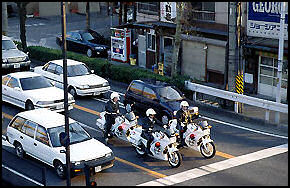
motorcycle police Many neighbohoodr residents volunteer for neighborhood patrols. As of 2007, there were 35,000 volunteer crime prevention groups in Japan. These include citizen koban s and volunteers that keep an eye on yakuza offices.
Tokyo has a chapter of Guardian Angels. Members crime patrol subway stations and bad neighborhoods late at night with $3,000 walkie talkie talkies. They rarely see any crimes. Mostly they spend their time picking up trash, removing pornographic pictures and helping out drunk teenagers and salarymen passed out on the sidewalks.
“Yonigeya” are “fly-by-night arrangers.” They are hired by people in trouble who seek to escape their predicaments or forge a new identity.Yonigeya have been hired by women escaping stalkers, wives fleeing abusive husbands and people in trouble with the yakuza or loan sharks. For their services yonigeya charge between $2,000 and $20,000 depending in how much work is involved.
Because their clients often owe lots of money, yonigeya often demand their money up front. To get close to clients that are constantly being watched they pose as delivery men and utility workers. Escapes are arranged after the people threatening a client are carefully studied. Clients are often moved to big cities where it easier for them to get lost in the crowd and escape notice. The clients are generally encouraged to leave everything behind — their credit cards, drivers license, possessions and cars . Tracking devises are often planted on them. Some clients adopt new identities but more often than not the yonigeya is just buying them some time until they can negotiate a deal with the people threatening them.
The detective business is also booming. Many of their clients are married women trying to catch their husbands having an affair or trying to get some evidence against their husbands so they can get a divorce. Detectives are also involved in locating missing persons, following teenagers whose parents think they are involved in prostitution or drugs. The detectives stake out brothels and love hotels and use hidden cameras and listening devices to gather information. Some employ “honey traps” to lure men into affairs with employees of the detective agency so their clients — wives — can get evidence for a divorce. Honey traps can cost $10,00 a month for expenses. One detective found a man having a love hotel affair with his 17-year-old daughter.
Cracking Down on the Crime in Japan
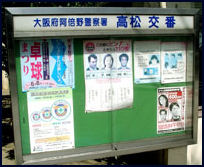
Police station
bulletin board Japan is starting to use GPS system to keep track of sex offenders. The GPS devices are attached to an ankle ring placed on repeat offenders. A similar system is used in the United States.
Blue lights have been set up as a deterrent to crime and suicides. In Nara, blue lights are credited with reducing crime by 9 percent in some places. Railways have set up blue lights at places where people are most likely to commit suicides, at the end of platforms and at railway crossings.
Flowers have been credited with reducing burglaries un Suginami Ward in Tokyo. The planting of flowers in empty lots has beatified run down areas and made pedestrians more likely to walk down them and report any suspicious activity. After the flowers were planted burglaries were reduced by 75 percent in the neighborhoods they were planted.
In 2009 a special police unit was set up to try and prevent crimes against women and children by investigating cases of inappropriate behavior towards women and children. In its first two months 168 persons were issued warnings or instructions. The warnings have no legal basis but are seen as a pre-emptive move to prevent incidents from happening.
Security Measures in Japan
Large numbers of security cameras have been installed in popular nightlife and drinking areas in Tokyo like Kabukicho. Police had 50 cameras installed in Kabukicho in response to rising crime rates.
In April 2010, the National Police Agency instructed police nation wide to begin cracking down more seriously on “small” crimes like shoplifting, littering, graffiti writing and other “behavior that could disrupt social order” as a way isolating petty criminals early and preventing from committing worse offenses. The aim of the effort was to make Japan “a society in which crimes cannot easily take place.”
Research by the Justice Ministry the recidivism rate among robbers and rapists in Japan is 40 percent.
The Japanese government is so security conscious that all carpenters in the entire country were ordered to keep their nail guns at home during an APEC meeting in Osaka in 1995. Before the meeting, carpenters and other workmen were sent letters telling them to keep the nail guns at home. Asked what he thought about the measures, a representative of nail gun manufacturer said that is very difficult use a nail gun as weapon. For one thing they don't aim very well. "it's much easier to hit someone with a hammer.”
Among the other measures taken in the $40 million security campaign before the 1995 summit were the removal of all trash cans (as possible bomb drop off points), the meticulous inspection of the stone walls around Osaka castle by repelling policemen, the curtailment of massage parlors and yakuza activity, the rounding up of homeless people and the dispersal of noodle vendors. Some 25,000 policemen (10 percent of the nations force) was placed on duty for the meeting.
During the Winter Olympics in Nagano in 1998, baseball tossing machines were locked up out of fear that they could be used by in a terrorist attack. The guns used in the biathlon were kept in high-tech rooms with optical scanners to keep intruders out.
Safety Measures at the World Cup in 2002
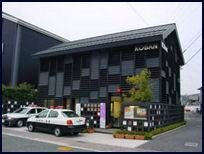
koban When Japan hosted the World Cup soccer tournament in 2002 there were big worries about hooliganism, particularly from hard-drinking British fans, some of whom were barred from entering the country. Security was tight during the games at the stadiums and before and after the games in nightlife areas. As many as 7,700 police, some with dogs and many with the latest plexiglass shields, showed up for the games.
Because of concerns about hooliganism parents kept their children indoor; schools were closed; barbers considered locking away their scissors lest they be used as deadly weapons; car dealerships near stadiums moved their inventory to prevent theirs from being stolen; businesses were offered “hooligan insurance”; courts cleared the dockets so hooligan cases could tried quickly; police were given the power to arrest suspected hooligans and detain them for three weeks without pressing charges; shopkeepers and residents near the stadiums were advised to pack away flower pots and bottles so they couldn’t be used as hooligan projectiles.
Brit-free zones were established to keep British fans separated from other fans. At some games the exit signs for British teams were in English while those of the other teams they were playing were in the language of that team. A Japanese railroad company worried about hooliganism glued down the stones that line the tracks near Shizuoka soccer stadium. Japanese rugby players were recruited for crowd control duties.
The government allocated $35.6 million for anti-hooligan measures, which including the development of special gun-fired nets that could be thrown on unruly fans and pole-mounted wire nooses that wrap around the ankles of rowdy hooligans and catch like wild animals. “The best way to defeat taller opponents would be to trip them and then subdue them on the ground,” police were told. In the end all the money and traing went for nought as nothing much happened.
Guns in Japan
Many Japanese have never seen a gun, which are also rarely seen on television except in American movies. In Japanese television murder mysteries the victims usually die from knife wounds, strangulation or poisoning not gunshots.
In Japan, handguns are illegal, not very many people hunt and only a handful of sportsmen and hunters own guns. There are about 300,000 legal, registered guns possessed by 170,000 owners and thought to be around 200,000 illegal guns circulating around.
The NPA said there were 45 shooting incidents in Japan in 2011, up 10 from the previous year, of which 32 involved associates of organized crime groups, an increase of 15. Police seized 426 guns last year, taking 121 of them from gangsters, the agency said. [Source: Kyodo, March 1, 2012]
The only people that legally carry guns are police and soldiers. Guards on armored trucks don't carry guns. Most police that are allowed to carry firearms keep their guns in safes. About the only people that carry illegal guns are yakuza members. Japanese sharply oppose to American gun policy. They find American love of guns to be distasteful and unfathomanable. Michael Moore’s anti-gun film “Bowling for Columbine” found a receptive audience in Japan.
The Japanese shoguns have the unusual distinction of being perhaps the only major rulers ever to eradicate firearms. In 1587, the shogun declared that all non-samurai were required to hand over weapons — both guns and swords — to the government, which had announced it was going to use the metal in the construction of an enormous statue of Buddha. All gunsmiths were ordered to take their workshops to the city of Nagahama, where the shogun could keep an eye on them and make sure they didn't make weapons.
The Japanese recognized the inherit instability that firearms created and they were able to get rid of them because Japan was an island country that focused on maintaining internal order and it was not threatened by any invaders. By 1706 the entire gun production of Japan was 35 large matchlocks, and only a handful of Japanese knew how to make firearms. The shoguns kept their country virtually free of firearms until Perry arrived in 1853.
The number of illegal and legal guns in Japan is rising. Guns are increasingly being involved in murders and other crimes.
Gun Control Laws in Japan
Japan has the world's strictest gun control laws. There is a total ban of handguns, except for legitimate antique gun collectors and licensed shooting teams. Japan gun control laws date back to 1588, just four decades after firearms were introduced by the Portuguese.
Getting a gun license takes an average of four months and a series of special training courses to acquire. Buying a hunting rifle requires enduring a lengthy waiting period and going through a rigorous background check. Japan's registered shotgun owners and licensed samurai swordsmen are required to keep their weapons in lockboxes that are inspected by police once a year. Even nail gun used by carpenters have to be registered. See Hunting, Activities
After a series of murders in the 1990s there were calls to tighten gun control. One suggestion was requiring gun owners to store their guns at gun dealers rather than keeping their guns at home.
According to Japanese gun laws a person who fires an illegal gun can be sentenced from three years up to life in prison. A person who owns an illegal gun can be sentenced from one to 10 years in jail. A person found with bullets can receive a sentence of up to three years.
The Nation Police Agency offer rewards of up to $1,000 for tip-off on illegal guns.
Crime, Guns, Knives and Other Weapons in Japan
Gun-related crimes are in Japan rare. Shooting incidents occur two to three times a week, with 20 to 40 people killed by guns each year.
There were only two shooting deaths in all of 2006. In 1998, a particularly bad year, there were 59 deaths attributed to guns with 40 of them designated accidental. By contrast there were more than 12,000 gun-related deaths in the United States the same year. In 1998 there were 158 felonies committed with handguns in Japan compared to 364,776 in the United States.
In September 2005, the owner of a model gun shop was arrested for providing parts to air gun owners that allowed them to transform their weapons into gas-powered guns powerful enough to wound or kill someone. Such guns were used in a spree of crimes in which gun fired on vehicles in highways. In Wakayama two vehicles had their windows shot out but luckily no one was hurt.
Tear gas sprays and stun guns are sometimes used crimes. Many of these can be purchased over the Internet or stores. There is no specific law outlawing them. One video store owner who was attacked with as a stun gun said they shock was great he collapsed on the floor and was unable to stand up. The explosion of a grenade in package in July 2003 brought attention to the availability of World War II ordnance through Internet auctions in Japan.
Knives are often used instead of guns in crimes. Some of the nastiest murdered have been committed with large kitchen knives or double-edged hunting knives. In October 2008, after such a weapons was used in a random, multiple murder in Akiharbara in Tokyo (See Famous Crimes), the government approved a bill banning the possession of highly-lethal double-edged knives.
Oyster knives and other knives with a symmetrical blade 5.5 centimeters or longer are subject to swords control law, which carry a maximum penalty of three years in prison and a fine of ¥500,000. Those who possess them are supposed to register with police.
A uniform manufacturer in Osaka has developed a T-shirt that provides protection from knife attacks. Costing between $170 and $450, the shirt is made with ultra thin polyethylene fiber similar that used in body armor and bullet-proof vests.
Last Suspect Dies in 1952 'Shiratori' Police Murder Case
In March 2012, the Yomiuri Shimbun reported: “The last man on the wanted list for the 1952 shooting and killing of a 36-year-old police officer in Sapporo has died in Beijing, it has been learned. The man, 82-year-old Michiya Tsuruta, died of illness in the Chinese capital in mid-March, a source close to the Chinese Communist Party said.
The incident is known as the "Shiratori" case because the victim's name was Kazuo Shiratori, who was then chief inspector at the Hokkaido police. After the murder of Shiratori on Jan. 21, 1952, 10 people suspected of being involved fled to China. Of them, seven returned to Japan while two died in 1988.
At the time of the incident, Tsuruta was a student at Hokkaido University and the No. 2 man in an underground militant arm of the Sapporo district committee of the Japanese Communist Party. The Hokkaido police believe he was the one who shot Shiratori.
After arriving in China aboard a fishing boat around 1955 together with another fugitive on the same wanted list, Tsuruta lived in Beijing first under the protection of the CCP and then went to Sichuan Province. He later moved to Beijing, where he entered education-related work in the late 1970s, according to acquaintances. He was married to a woman from Sichuan and had two children.
Image Sources: Ray Kinnane, Japan Visitor, Japan Photo japan-photo.de
Text Sources: New York Times, Washington Post, Los Angeles Times, Daily Yomiuri, Times of London, Japan National Tourist Organization (JNTO), National Geographic, The New Yorker, Time, Newsweek, Reuters, AP, Lonely Planet Guides, Compton’s Encyclopedia and various books and other publications.
Last updated January 2013
